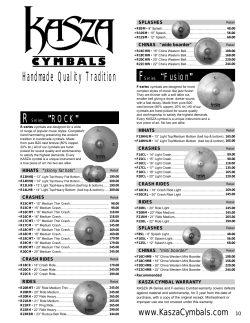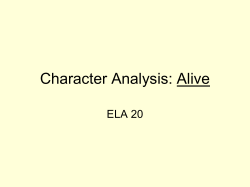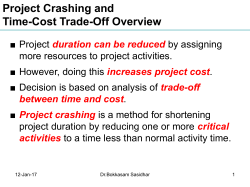
Review problems and solutions
Review problems and solutions 1. For the Project network shown answer the following questions based on the data provided. You can use Excel to assist you in solving the problem, but you still need to show your work pretending you solve by hand. A B E G J D C Activity A B C D E F G H I J K (a) (b) (c) Expected time(weeks) 3 2 8 1 6 4 5 1 3 5 6 I F H K Standard deviation .3 .5 2.0 .2 1.0 .2 .4 .1 3 1.0 .6 What is the critical path? What is the probability of meeting a desired 26 weeks completion time? Several activities can be expedited for a cost. Specifically, activity D expected time could be reduced by 10% for a cost of $500, or by 20% for a cost of $2000. If the project is not completed in 26 weeks a penalty of $100,000 will be paid. What is your recommendation regarding expediting activity D? Assume the standard deviations don’t change. Solution To solve with Excel enter the data to the PERT-CPM. Since the standard deviation and the expected time for each activity are given, the three time estimates are not needed. Run the CPM-PERT template and obtain the following result: (a) The critical path is CDEGIK. (b) P(X<26)= [Use PERT-CPM]=P(Z<(26-29)/3.8158)=.2159. You need to explain this result. X is normally distributed with mean = 29 and standard deviation = [22+.22+12+.42+32+.62]1/2=3.8158 (c) We apply the expected value criterion: (i) Not reducing the completion time of activity D: E(Cost)=0P(X<26)+100,000P(X>26)=100,000(.7841)=78410 (ii) Reducing the expected completion time of activity D by 10%. New time=.9. From the template we have P(X<26)=.2236 so P(X>26)=.7764. E(Cost)=0P(X<26)+100,000P(X>26)+500=100,000(.7764)+500=78140 (iii) Reducing the expected completion time of activity D by 20%. New time=.8. From Excel we have P(X<26)=.2315 so P(X>26)=.7685. E(Cost)=0P(X<26)+100,000P(X>26)+2000=100,000(.7685)+2000=78850 Conclusion: Allocate $500 to expedite activity D by 10%. 2. The following data pertains to a certain project: Immediate Normal Normal Activity Predecessor. Time(weeks) Cost __ A 10 30 B A 8 120 C B 10 100 D A 7 40 E D 10 50 F C, E 3 60 (a) (b) (c) (d) Crash Time(weeks) 8 6 7 6 8 1 Crash Cost 70 150 160 50 75 95 Show the project network Assume the company wants to complete the project in 28 weeks. Should any activity be crashed? Explain. Which activities should be crashed, by how much, and at what total crashing cost, if the objective is to minimize the total crashing costs, while meeting the deadline of 28 weeks? Assuming there is a penalty of 20 paid for each week the project is not completed beyond the deadline of 28 weeks. What is the optimal crash plan that minimizes total costs? Solution: (b) We run Excel and realize that the project needs to be crash since the normal project completion time is 31 weeks. (c) From the Excel printout we have: Activity B is crashed by 1 week and activity F is crashed by 2 weeks. (d) We need to formulate this problem as a linear programming model, because the PERT-CPM template does not provide a solution to this problem. The linear programming model: Minimize Crash cost + penalties = 20YA+15YB+20YC+10YD+12.5YE+17.5YF+20(Delta) S.T. Activity F Delta = XF+3-YF-28 28 XF XF+3-YF XB>=XA+10-YA Delta XCXB+8-YB XDXA+10-YA XEXD+7-YD XFXE +10-YE XFXC+10-YC YA2 YB2 ……… XF-YF-DELTA=25 -XA+XB+YA 10 -XB+XC+YB 8 -XA+XD+YA 10 -XD+XE+YD 7 -XE+XF+YE 10 -XC+XF+YC 10 Using Solver to solve this linear programming model, the start times of each activity appears in the list of X values. Also, read the amount of time reduction for each activity from the list of Y values. For example, activity B starts at time 10 and takes 8 – 1 = 7 weeks to complete [Normal time – time reduction = 8 –1]. The project is completed in 30 weeks [XF+3-YF = 27+3-0], therefore, the delay measured by the variable DELTA is equal to 2 weeks [30-28]. Thus, with the penalty of 20 per week of tardiness, it pays to be late by two weeks; the project is crashed by 1 week (from 31 to 30). Another way to solve the problem is by running the CPM-Deadline multiple times, changing the deadline, and adding the appropriate penalty manually. For example: Let deadline = 28. This yields a certain crash costs, say C1. No need to add any penalty. Let deadline = 29. This yields a crash cost of C2, smaller than C1, but we need to add a penalty of 20. Continue with this manner. Note that you do not need to go below a deadline of 28, because the crash cost will increase compared to C1. Also note, that there is no need to go beyond 31(the completion normal time), because no crash will be needed but the penalties accumulate. 3.
© Copyright 2025





















